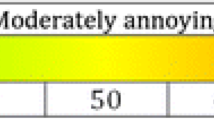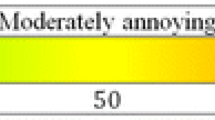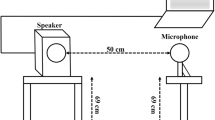Abstract
Background
Although snoring is a common problem, no unequivocal definition yet exists for this acoustic phenomenon. The primary study objective was to investigate whether snoring sounds can be distinguished at all clearly from breath sounds. Our secondary objective was to evaluate whether the sound pressure level in common use and psychoacoustic parameters are suitable for making this distinction.
Methods
Twenty-five subjects exposed to 55 sound sequences were asked to decide whether these were breath sounds or snoring sounds, and to indicate how certain they were about their decision. The sound pressure level and the psychoacoustic parameters of loudness, sharpness, roughness, and fluctuation strength were then analyzed, and psychoacoustic annoyance was calculated from these parameters.
Results
Sixteen percent of the sound sequences could not be classified unequivocally, although the individual raters stated that they were still moderately certain about their decision. The sound pressure level and psychoacoustic parameters were capable of distinguishing between breath sounds and snoring sounds. The optimum for sensitivity and specificity was 76.9 and 78.8 %, respectively.
Conclusions
Because snoring appears to be a subjective impression, at least in part, a generally valid acoustic definition therefore seems to be impossible. The sound pressure level and psychoacoustic parameters are suitable for distinguishing between breath sounds and snoring sounds. Nevertheless, when interpreting results, the only moderate validity of these parameters due to the absence of a universally valid definition of snoring should be taken into account.




Similar content being viewed by others
References
Singh V, Pandey S, Singh A, Gupta R, Prasad R, Singh Negi MP (2012) Study pattern of snoring and associated risk factors among medical students. Biosci Trends 6:57–62
Franklin KA, Janson C, Gíslason T, Gulsvik A, Gunnbjörnsdottir M, Laerum BN, Lindberg E, Norrman E, Nyström L, Omenaas E, Torén K, Svanes C (2008) Early life environment and snoring in adulthood. Respir Res 9:63
Dalmasso F, Prota R (1996) Snoring: analysis, measurement, clinical implications, and applications. Eur Respir J 9:146–159
Gavriely N, Palti Y, Alroy G (1981) Spectral characteristics of normal breath sounds. J Appl Physiol 50:307–314
Gavriely N, Palti Y, Alroy G, Grotberg JB (1984) Measurement and theory of wheezing breath sounds. J Appl Physiol 57:481–492
Herzog M, Schmidt A, Bremert T, Herzog B, Hosemann W, Kaftan H (2008) Analyzed snoring sounds correlate to obstructive sleep disordered breathing. Eur Arch Otorhinolaryngol 265:105–113
Perez-Padilla JR, Slawinski E, Difrancesco LM, Feige RR, Remmers JE, Whitelaw WA (1993) Characteristics of the snoring noise in patients with and without occlusive sleep apnea. Am Rev Respir Dis 147:635–644
Fiz JA, Abad J, Jané R, Riera M, Mañanas MA, Caminal P, Rodenstein D, Morera J (1996) Acoustic analysis of snoring sound in patients with simple snoring and obstructive sleep apnea. Eur Respir J 9:2365–2370
Abeyratne UR, Wakwella AS, Hukins C (2005) Pitch jump probability measures for the analysis of snoring sounds in apnea. Physiol Meas 26:779–798
Ben-Israel N, Tarasiuk A, Zigel Y (2012) Obstructive apnea hypopnea index estimation by analysis of nocturnal snoring signals in adults. Sleep 35:1299–305C
Stuck BA, Abrams J, La Chaux R, de Dreher A, Heiser C, Hohenhorst W, Kühnel T, Maurer JT, Pirsig W, Steffen A, Verse T (2010) Diagnosis and treatment of snoring in adults–S1 guideline of the German Society of Otorhinolaryngology, Head, and Neck Surgery. Sleep Breath 14:317–321
Caffier PP, Berl JC, Muggli A, Reinhardt A, Jakob A, Möser M, Fietze I, Scherer H, Hölzl M (2007) Snoring noise pollution—the need for objective quantification of annoyance, regulatory guidelines, and mandatory therapy for snoring. Physiol Meas 28:25–40
Esser AM (2002) Snoring in the ancient world. Sleep Breath 6:29–39
Gavriely N, Jensen O (1993) Theory and measurements of snores. J Appl Physiol 74:2828–2837
Wilson K, Stoohs RA, Mulrooney TF, Johnson LJ, Guilleminault C, Huang Z (1999) The snoring spectrum: acoustic assessment of snoring sound intensity in 1,139 individuals undergoing polysomnography. Chest 115:762–770
Gill AI, Schaughency E, Gray A, Galland BC (2013) Reliability of home-based physiological sleep measurements in snoring and nonsnoring 3 year olds. Sleep Breath 17:147–156
Pevernagie D, Aarts RM, de Meyer M (2010) The acoustics of snoring. Sleep Med Rev 14:131–144
Hoffstein V, Mateika S, Anderson D (1994) Snoring: is it in the ear of the beholder? Sleep 17:522–526
Iriarte J, Fernández S, Fernandez-Arrechea N, Urrestarazu E, Pagola I, Alegre M, Artieda J (2011) Sound analysis of catathrenia: a vocal expiratory sound. Sleep Breath 15:229–235
Kreivi H, Salmi T, Maasilta P, Bachour A (2013) Screening of snoring with an MP3 recorder. Sleep Breath 17:77–84
Lee BW, Hill PD, Osborne J, Osman E (1999) A simple audio data logger for objective assessment of snoring in the home. Physiol Meas 20:119–127
Beck R, Odeh M, Oliven A, Gavriely N (1995) The acoustic properties of snores. Eur Respir J 8:2120–2128
Cathcart R, Hamilton D, Drinnan M, Gibson G, Wilson J (2010) Night-to-night variation in snoring sound severity: one night studies are not reliable. Clin Otolaryngol 35:198–203
Hoffstein V (1996) Snoring. Chest 109:201–222
Fastl H, Zwicker E (2007) Psychoacoustics: facts and models. Springer, Berlin, New York
Cavusoglu M, Kamasak M, Erogul O, Ciloglu T, Serinagaoglu Y, Akcam T (2007) An efficient method for snore/nonsnore classification of sleep sounds. Physiol Meas 28:841–853
Duckitt WD, Tuomi SK, Niesler TR (2006) Automatic detection, segmentation, and assessment of snoring from ambient acoustic data. Physiol Meas 27:1047–1056
Brietzke SE, Mair EA (2007) Acoustical analysis of pediatric snoring: what can we learn? Otolaryngol Head Neck Surg 136:644–648
Blumen MB, Quera Salva MA, Vaugier I, Leroux K, d'Ortho M, Barbot F, Chabolle F, Lofaso F (2012) Is snoring intensity responsible for the sleep partner's poor quality of sleep? Sleep Breath 16:903–907
Kühnel TS, Schulte-Mattler W, Bigalke H, Wohlfarth K (2008) Treatment of habitual snoring with botulinum toxin: a pilot study. Sleep Breath 12:63–68
Herzog M, Bremert T, Herzog B, Hosemann W, Kaftan H, Müller A (2010) Analysis of snoring sound by psychoacoustic parameters. Eur Arch Otorhinolaryngol: 1386–1389
Rohrmeier C, Herzog M, Haubner F, Kuehnel TS (2012) The annoyance of snoring and psychoacoustic parameters: a step towards an objective measurement. Eur Arch Otorhinolaryngol 269:1537–1543
Ng AK, Koh TS, Baey E, Puvanendran K (2009) Role of upper airway dimensions in snore production: acoustical and perceptual findings. Ann Biomed Eng 37:1807–1817
Hara H, Murakami N, Miyauchi Y, Yamashita H (2006) Acoustic analysis of snoring sounds by a multidimensional voice program. Laryngoscope 116:379–381
Herzog M, Kühnel T, Bremert T, Herzog B, Hosemann W, Kaftan H (2009) The impact of the microphone position on the frequency analysis of snoring sounds. Eur Arch Otorhinolaryngol 266:1315–1322
Disclosure statement
There are no institutional or corporate affiliations of the authors and there are no funding sources which supported the work.
Author information
Authors and Affiliations
Corresponding author
Rights and permissions
About this article
Cite this article
Rohrmeier, C., Herzog, M., Ettl, T. et al. Distinguishing snoring sounds from breath sounds: a straightforward matter?. Sleep Breath 18, 169–176 (2014). https://doi.org/10.1007/s11325-013-0866-8
Received:
Revised:
Accepted:
Published:
Issue Date:
DOI: https://doi.org/10.1007/s11325-013-0866-8




